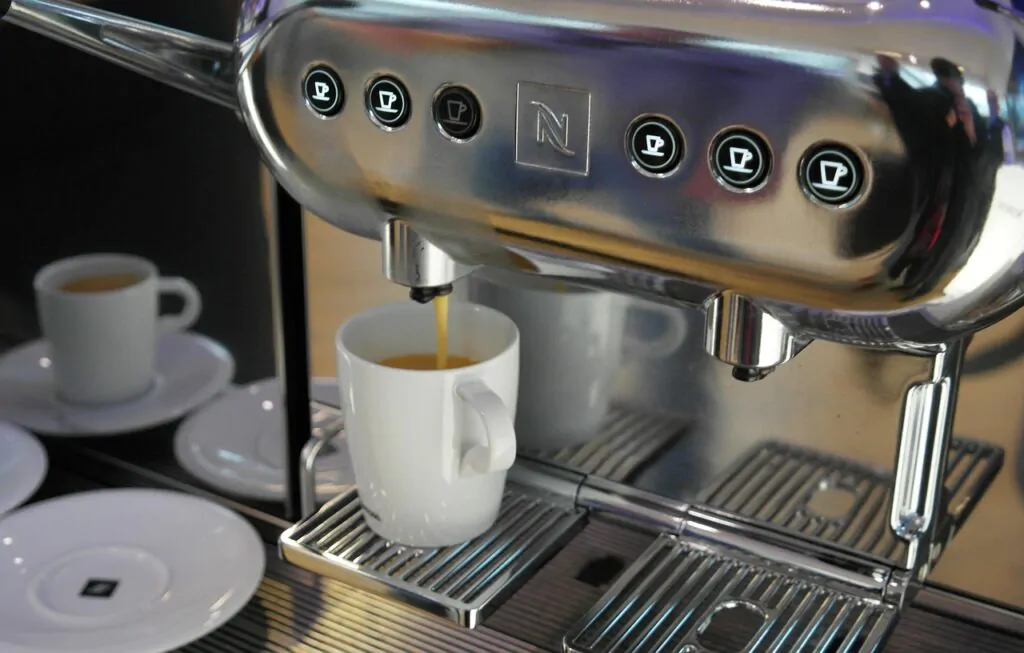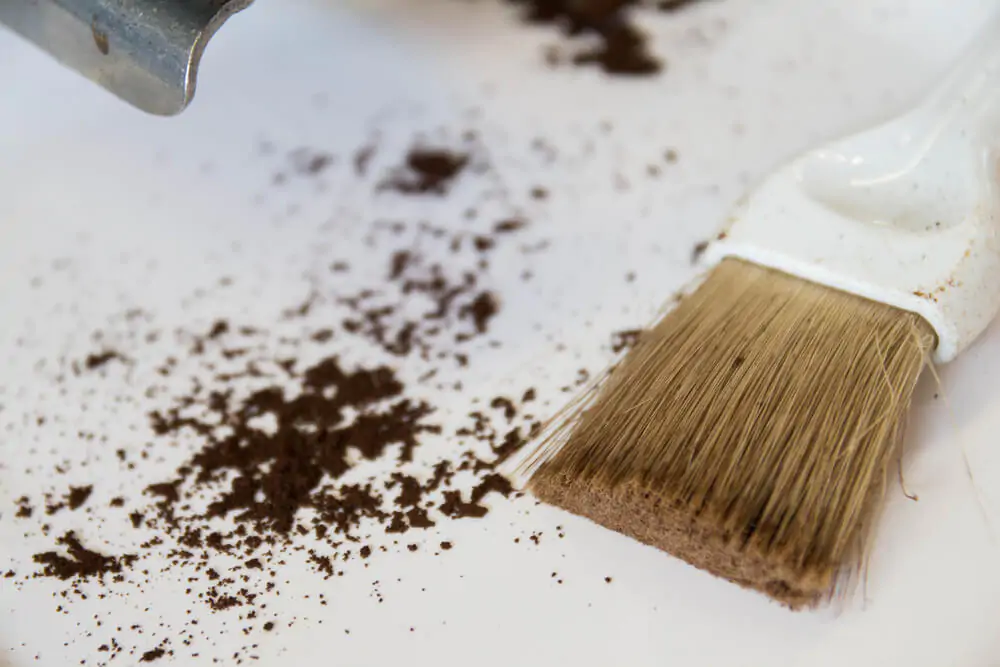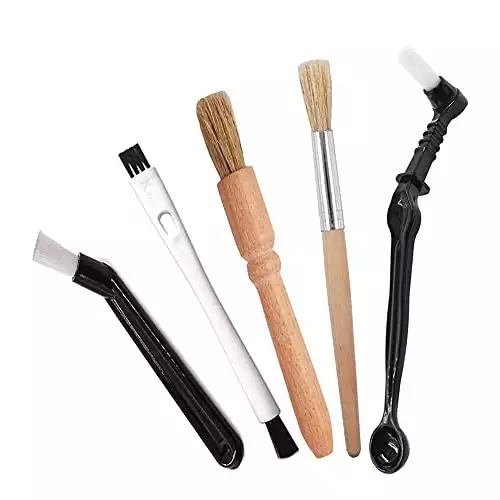Learn how to clean coffee machines with a coffee brush and know why you should clean them regularly through this article.

Did your usual coffee blend taste different this morning? Even if you already cleaned your coffee machine, how sure are you that it’s thoroughly cleaned?
A study concluded that 50% of the coffee makers had yeast or molds. These molds cause allergies, and infections, and can be the reason for the bad taste in your cup of Joe.
Cleaning coffee machines with a coffee brush is a quick, efficient, and easy way of scrubbing and wiping off excess grinds and other residues like coffee sludge in your coffee maker. But when and how should you clean your coffee machine with these brushes?
Coffee Machines And Coffee Brush

There are two types of coffee makers: automatic and manual. A coffee brush is essential for cleaning coffee machines, equipment, and other tools. Baristas use this tool to clean the coffee group head, remove coffee grounds and residues from the gasket, scrub the screens, and reach the tricky corners of the machine.
The best coffee brush to use in cleaning coffee machines are those with bristles made from organic materials. It’s softer than nylon bristles and more effective for scrubbing. However, they come with a steeper price tag.
Try DXary’s Set of 5 Coffee Machine Cleaning Brushes for cheap but high-quality brushes to maintain your coffee machine.
- Package Include: 5 Pieces coffee cleaning brush set in total, 3 pieces nylon espresso brush (In 3 size) and 2 pieces wood coffee brush(In 2 Size). Convenient for you to exchange,cleaning grinder quick and easy.
- Nylon Espresso Brush: The nylon coffee brush have sturdy bristles can clean what coffee remains and your coffee grinder burr blades easily. And we have three kind size can help you clean everywhere include in gap.
- Wood coffee Cleaning brush: This brush has an attractive wooden handle and uses long, durable fibers to clean deeply. Long wood brush is the perfect way to get into all the little nooks. Also fit for coffee grinder, espresso machine, milk frothers, bean grain and coffee maker
- Best Cleaning Tool: To clean your group head burr blades, coffee grinder espresso machine milk frothers bean Grain and coffee maker, Notice: A small amount of bristles shedding is normal, Please feel free to use!
Cleaning Vs. Descaling
Regular cleaning of equipment and tools used to make coffee is critical to avoid bacteria, germs, and unwanted tastes. To prevent contamination and make your coffee machine last longer, you need to wipe down the machine after brewing, handwash it every day, and descale once a month.
Cleaning your coffee machine must be done daily. Cleaning includes throwing out used grounds and filters, wiping out coffee residue, and drying the water reservoir. You should also wash all the detachable parts with hot water, soap, and a sponge or coffee brush to scrub away germs and coffee oils buildup.
On the other hand, descaling is a process of removing mineral build-up. It’s usually done every three to six months, but it can also be monthly.
Water minerals such as calcium and magnesium accumulate in the heating element, damaging the coffee maker and resulting in less flavorful coffee. You can combine vinegar and water in the chamber, place a new filter, and run a cycle twice to descale your machine.
Are you not a fan of vinegar’s smell? Check out our explainer on how to clean your coffee maker without vinegar?
How To Clean Each Coffee Machine With A Coffee Brush
Ready to clean your coffee maker? Here’s a step-by-step guide on cleaning any coffee machine with a coffee brush.
You might be interested in our are coffee machine worth it.
For French Press
Prepare:
- Long coffee brush
- Mesh strainer
- Dish soap
- Baking soda
- Soft cloth
Steps:
- Remove the plunger and fill the glass with warm water. Swirl for a bit to loosen the coffee grounds.
- Grab the mesh strainer and pour the water and grounds into it. Throw the coffee grounds away.
- Start scrubbing to remove the oils and coffee stains using the brush, dish soap, and warm water.
- Use baking soda for stubborn coffee residue if you need to.
- Rinse it well and let it dry.
For Aeropress
Prepare:
- Coffee brush
- Water
- Dish soap
Steps:
- Unscrew the cap and long-press the Aeropress until the filter and condensed coffee grounds pop out.
- Carefully clean and rinse out the coffee maker and wipe the rubber seal in the plunger.
- Use the brush and soap to scrub the residues and rinse them well. Let it air dry.
- After use, always do this and pay attention to the plunger’s rubber gasket.
For Percolators
Prepare:
- Coffee brush
- Baking soda
- Water
- White vinegar
Steps:
- Pour water into the percolator.
- Put three tablespoons of baking soda. Turn it on and brew.
- Once the water is cool enough, scrub the inside of the coffee machine with the coffee brush.
- Rinse it well.
- Mix half cup water and half cup vinegar in the percolator and let it sit for a few minutes, and discard the water.
- Repeat the step with clean water and rinse the percolator well.
For Keurig
Prepare:
- Coffee brush
- Dish soap
- Towel
- Cleaning cloth
- All-purpose cleaner
- White vinegar
- Water
- Large mug
Steps;
- Fill up the sink with boiling water and one tablespoon of dish soap.
- Take out the water reservoir, drip tray, cover, holder, and funnel. Let it soak in the sink for 15 minutes.
- After 15 minutes, rinse well and towel dry everything.
- Grab the coffee brush and brush out all the coffee grinds stuck inside the K-Cup holder.
- With an all-purpose cleaner and dampened cloth, wipe the inside and outside of the machine.
- Optional: If there’s a limescale deposit, apply a cloth soaked in white vinegar to the area and wipe again.
- Grab the mug in the tray and empty the water reservoir (remove the water filter if your machine has it) and pour a 1:1 ratio of water and white vinegar solution.
- Turn the Keurig on and start brewing until there’s no more solution in the reservoir.
- Let your machine rest for 30 minutes and rinse it with water to eliminate any white vinegar residue.
- Repeat step seven but with plain water.
You might also be interested in our explainer on can you use coffee capsules without a coffee machine.
For Espresso Machine
Prepare:
- Espresso machine cleaning powder
- Blind portafilters
- Group head coffee brush
- Two one-litre cleaning containers
- 500ml cleaning container
- Milk frother cleaner
Steps:
- Remove the portafilter from the machine and take out the portafilter basket.
- Insert the blind portafilters (cleaning blank) and add three grams of espresso machine cleaning powder.
- Insert the portafilter back to the group head and brew for 15 to 20 seconds. Let it sit for 60 seconds and repeat five times.
- Remove the portafilter and rinse.
- Using the group head coffee brush, scrub the rubber seal in a circular motion to remove the old coffee grounds. After scrubbing, start a cycle to flush out the remaining coffee residues.
- For the other group heads, repeat the first five steps.
- Fill up the one litre container with boiling water and six grams of cleaner. Soak the portafilter and basket and clean blank for 15 minutes. Rinse well and dry using a clean cloth.
- Grab the other container and pour 500ml cold water and 30ml milk frother cleaner to make a cleaning solution for the steam wand.
- Submerge the wand in the solution and steam for five seconds. Repeat seven times and wipe with a clean cloth.
- Repeat the second with clean cold water.
Backwashing is difficult as not all espresso has a backwash or backflush facility. Consult the brand or check the machine manual before cleaning to avoid damage.
If you’re torn between buying a Nespresso or an Espresso machine, read our Nespresso vs. an espresso machine guide to help you decide.
Benefits Of Cleaning Coffee Machines
Regular cleaning and scheduled descaling are vital to ensuring that your coffee machine is excellent and safe to use.
Below are the advantages of cleaning your coffee machines:
- To consistently brew an unsullied cup of Joe.
- For the coffee machine to last longer.
- For healthy and safe brewing.
- To save money by avoiding repair or new purchases.


